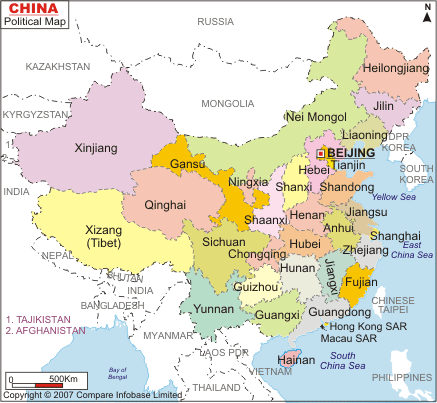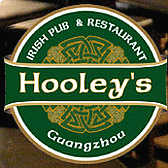|
|
| Chinese
History |
The Son of
Heaven
|
|
This is a short section
provided as a little diversion for those who wish to
understand the Chinese psyche and their inherent view
of the world in simple terms. Although factually correct,
please read this as an aside and not a serious work
of history. However, by comprehending the implications
of this page, you will find understanding the whole
of Chinese history to be far easier.
The Son of Heaven
To understand Chinese people, you first need to understand
how they see the world
Chinese culture is based around the concept of centrality.
This comes from the earliest sources, and reflects
the early Emperors who termed themselves as being
“The Son of Heaven”. They ruled “The
Known World”, and anything outside of their
knowledge was the unknown world. However, unlike Egyptian
rulers, there was allowance for an Emperor to ‘go
bad’, and it was accepted that in such an instance,
‘god’ would replace him by another with
better credentials – hence the different dynasties
There are two important things you should know:
1. Centrality:
a) One big problem people find is that they do not
realise how Chinese people conceptualise China. It
is a little similar in UK, where Londoners tend to
think of Midlanders (80 miles away) as being on the
border of Scotland (600 miles). Lets have a look at
this for your comprehension of China
i. ‘The Centre of China’ has been regarded
for millennia as Henan/Shaanxi + Hebei Provinces.
Lets be specific: today it is called Beijing, but
previously may have been called Xi’an, or another
city on the middle or lower reaches of the Yellow
or Yangtze Rivers
ii. When I look at a world map, I see Beijing is Northeast
in China.
iii. Yesterday the news stated that ‘In the South’,
Shanghai was …’Blahblahblah’. Check
the world map again and sure: Shanghai is South of Beijing
on the Eastern coastline, in the middle latitudes of
China.
b) So what's going-on?
i. Geography. Physical geography we call terrain.
ii. Cultural Heritage over millennia
c) This all gives a distorted view of China, so let
me try and simplify it for you:
i. Central China is: Beijing
ii. Northern China is: Heilongjiang Province and Harbin
City
iii. Inner Mongolia is always called simply ‘Mongolia’.
It is never referred to as Northern China or Inner
Mongolia. The independent Country of Mongolia has
a different name
iv. Xi’an is often referred to as being in ‘Western
China’
v. The West of China is always called QingHai, and
this should be considered as a region not simply a
Province, as overlapping references to Western Gansu
are often topic related
vi. The very extreme West is called XinJiang, and
this is Urgar country
vii. Why is this you may wonder?
1. Well, there is one very big reason, which is called
The Taklamakan Dessert. North lies The Mongols. South
lies the Tibetan Plateau. And the bit in between is
one of the harshest and most invasive desserts on
the modern planet. Therefore it is easy to conceptualise
that main China finishes before the Taklamakan dessert.
Then there is the dessert itself. And finally there
is another part of China that is very far to the West.
Simple!
2. Hence ‘The Silk Road(s)’ Northern (Summer)
and Southern (Winter) routes; both skirting the Taklamakan
Dessert
viii. Tibet is always called ‘Tibet’ or
XiZang in Chinese
ix. “South” is a bit complicated, because
this can be generalised or specific. Normally expect
‘South China’ to mean Yunnan Province;
yet be prepared for it to mean Sichuan Province, and
sometimes even Shanghai!
x. Southeast China can mean many things; and Beijingers
usually mean a line across Guangxi, Guizhou, Hunan,
Hubei, Jiangxi, and Fujiang Provinces – and both
Guangdong and Hainan lie Southeast of these!
xi. Guangdong is actually in the extreme Southeast of
China; but is usually referred to as Guangdong Province,
or commonly: The Pearl River Delta. It is ringed by
impenetrable mountains with only one pass headed north,
which was often too severe even for donkeys to traverse.
xii. Hainan Island and the South China Sea Islands
are … a very long way away, and are always referred
to specifically
xiii. 
xiv. Map courtesy of http://www.chinamapxl.com/political-map.html
2. Language:
a) Chinese characters show this really well, as language
is a conceptual form to Chinese people, not a logical
process. Lets look at some very simple characters:
i.  Looks like a man with legs together, arms down .
Looks like a man with legs together, arms down .
1. Meaning: Mandarin = Xiao (Cantonese
= Siu)
a) Lit: small
b) Conceptual: Small
Face, small person
c) Perception: An unimportant
person or thing
ii.  Looks like a man with legs apart, arms outstretched.
Looks like a man with legs apart, arms outstretched.
1. Meaning: Mandarin = Da (Cantonese
= Dai)
a) Lit: Large
b) Conceptual: Big
Face, great person
c) Perception: An important
person or thing
iii.  Looks like a large man wearing a Crown.
Looks like a large man wearing a Crown.
1. Meaning: Mandarin = Qian (Cantonese
= Tian)
a) Lit: Grand, (Money
= 1, 000 RMB)
b) Conceptual: Ruler,
King = The Son of Heaven
c) Perception: ‘Everything
Under the Emperor’ or ‘The Known World’
iv.  Looks like a great man wearing a crown, with the sky
above him . This is a very old character that is not
used today in Simplified Chinese script (Mandarin)
Looks like a great man wearing a crown, with the sky
above him . This is a very old character that is not
used today in Simplified Chinese script (Mandarin)
1. Meaning: (Cantonese = Maa)
a) Lit: Space
b) Conceptual: Heaven
c) Perception: ‘Everything
Above the Emperor’, heaven, stars; ‘The
Son of Heaven’
i. This
can never be another (wo)man!
1. So, if another man is this, then he is the
new Emperor
2. Westerners tend to get this meaning wrong,
and see it as a threat to themselves, which it is
not. This is conceptual Chinese thinking only.
v.  There is another similar character, with yet
another line over the top – but not many Chinese
scholars even know of its existence today. This character
means ‘god’
There is another similar character, with yet
another line over the top – but not many Chinese
scholars even know of its existence today. This character
means ‘god’
1. Meaning: (Cantonese = Maa-Maa: Coll.
Mama or First Mother).
2. Properly a reference to Nüwa
or Mother Earth, which you may recognise as Gaia or
Eve
3. My persuasion is that here the preference
changes, and this becomes an obviously female character
3. Perception
Our point is that Chinese history develops from a small
area of land between Beijing and Xi'an cities, and from
where the Yellow and Yangtze rivers come close together.
This is the cradle of Han Chinese culture, and as they
expanded control over millennia, so their vassal states
became incorporated into the Han Chinese unit.
But China is ever the land of contradictions, which
is why many find it so fascinating. For instance, Cantonese
peoples are highly assimilated into Han Chinese culture,
yet are the only group to be officially allowed to speak
a language that is not Mandarin (Internationally approved).
You may state that Tibetans also speak their own language,
and you would be correct in theory perhaps. However,
Beijing does not approve of Tibetan as a world language,
but considers it a Chinese dialect.
Peoples that are not totally assimilated into Han Chinese
culture are called 'Ethnic Minorities', and whilst they
have their own unique cultures, traditions, and languages;
these 57 cultural groups exist as small entities within
their own right - within the Han Chinese sphere of control.
If you have an open mind to understand contentious issues
like Tibet, then you should start here by looking at
the interactions between the mainly southern minorities
of Yunnan and Guizhou provinces (Generalised). It all
comes back to this concept of centrality, and if you
were to consider the Sun to represent Han Chinese supremacy;
then the planets and moons etc would perhaps represent
minority groups and interests. This also explains Taiwan
- but to understand that particular hedgehog you may
need to read our Modern
History of China section.
We will wrap this page up here and hope you found it
both entertaining and enlightening. In our Chinese History
section we have taken Chinese history apart in some
ways, and detail Kingdoms and countries as separate
entities before becoming a part of the Han Chinese central
unit. This is difficult, as no one has attempted this
before, so our page(s) detailing Independent
Kingdoms (Before becoming a part of Greater China)
is a work in progress, and will probably remain so -
for the more we learn and relate, so the more we find
left to write about. |
|
This information is as supplied by Wikipedia, as dated
March 2009 or later, and/or other reliable sources.
Maps (Unless stated otherwise)
are provided in association with Thomas Lessman
Web: www.worldhistorymaps.info
Disclaimer:
Please check this information yourself as it may alter
without notice, and whilst we try our best to ensure
it is correct, please do not hold us responsible for
any errors - this is intended as a simple guide only |
|
| Search
this Website |
|
|
| Our
Friends |
Excellent
& Free Online Chinese Language Portal

Thousands of free print-friendly Chinese reference sheets,
tests and revision aids.
Easy Learning format &
Listen to Spoken Words |

Professional
Visa Services
Company
Formation Packages
.
|

British Foreign Office
Resource and Advice for Travellers Worldwide |

Chinese Embassy in UK
Information About China
International Relations
Visa & Consular |

UK Embassy in China
Information About UK
International Relations
Visa & Consular |

|
Excel
Education |
Languages Courses
Study Abroad
Employability
Summer Camps
Information for Teachers |
|

Excellent and relaxing base to
explore this most beautiful of regions in all China! |
Down The Road.org
How We Traded Our Ordinary Lives For a Global Bicycle Touring Adventure

See
Us in China |

Empowering Underprivileged Children
& Their Communities = Worldwide |
 |

Based in Shangri-la,
Yunnan
Province
Dedicated to Exploring Remote Areas of China
Committed to Nature Conservation and Preserving Ethnic
Cultures & Traditions
|

Based in Xi'an,
China's Premiere Travel Agency and International Travel
Community -
Committed to providing:
Best travel deals & current information for all
International Travellers |

Pearl Dragon
Vast
Online Trading and Information Resource
Link goes to Chinese Tourism and Galleries Section |
|